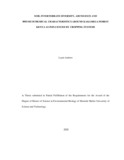| dc.contributor.author | Lyani, Andrew | |
| dc.date.accessioned | 2020-12-11T09:06:48Z | |
| dc.date.available | 2020-12-11T09:06:48Z | |
| dc.date.issued | 2020-11-12 | |
| dc.identifier.uri | http://r-library.mmust.ac.ke/123456789/1443 | |
| dc.description.abstract | Soil fertility depletion has been identified as a major cause of food insecurity among householdsaround Kakamega forest. Soil invertebrate abundance and diversity are known to influence fertilitylevelof soil in agricultural farms. In western Kenya there is limited knowledge on the benefit of conserving soil invertebrates among farmers. There is need for conservation of soil invertebrates in cropping systems because they play a role in influencing soil fertility. The general objective of the study was to determine soil invertebratediversity, abundance and physichochemical characteristics around Kakamega forest Kenya as influenced by cropping systems. Specific objectives were; (i.)to determine levels of biodiversity andabundance of soil invertebrate species in different cropping systems around Kakamega forest, (ii.) to determine levels of selected soil physicochemical properties under different cropping systems and (iii.) to determine the type and levels of relationshipbetween selected cropping systems verses soil invertebrate and physicochemical levels.The hypotheses of the researchwere that; (i.) there were no levels of biodiversity and abundance of soil invertebrate species in different croppingsystems around Kakamega forest, (ii.) there were no levels of selected physicochemical properties under varying cropping systems around Kakamega forest and (iii.) there were no type and levels of relationship between selected cropping systems verses soil invertebrates and physicochemical characteristics.Purposive sampling technique was used where five cropping systems and the forest were selected.The cropping system treatments include pure maize, pure beans, tea, sugarcane,maize/beans intercrop and the forest acted as a control. Data was collected on soil invertebrates and soil chemical properties (pH, Organic carbon, nitrogen and phosphorous).Soil samples were collected and extraction ofsoil invertebrates done using Berlese tullgren funnel. Identification of invertebrateswas done at National Museum Kenyaup togenus and species level. Determination of the diversity and abundance of soil invertebrates was done using Shannon diversity index computed using the R version 2.10.0and Kruskal-wallis test. Nitrogen analysis was done using UV-vis spectrophotometer while phosphorous was done by Mehlich 3 test and organic carbon was done by Walkey-Black method. The relationship between species abundance and nutrient level in the cropping systems was analyzed using a multiple correlation model within theGeneralized Linear Methodframework. A total of 1,215 individual soil invertebrates belonging to 29 species were collected. The forest had the highest diversity (H’=2.81) for both wet and dry season followed by maize cropping system (H’=2.29) and least was in bean farm (H’=1.78). The highest percentage nitrogen recorded in the maize plantation with a mean of 0.65, followed by the maize and beans intercrop with a mean of 0.585 and tea plantations with a mean of 0.419.Phosphorous was highest in beans farm with 2.20%, followed by tea plantations with 1.68%. The highest organic carbon was recorded in forest ecosystem 3.58%followed by beans 2.18% and maize 2.08%. No correlation was found between diversity and abundance with the physicochemical properties.The findingsfrom this study will enable farmers practice thebest cropping systems which have less effect on the diversity of soil invertebrates hence conservation of the invertebrates. | en_US |
| dc.description.sponsorship | MMUST | en_US |
| dc.language.iso | en | en_US |
| dc.publisher | MMUST | en_US |
| dc.subject | Soil, Invertabrate, Diversity, Ubundance, Physicochemical, Characteristics, Cropping, Systems | en_US |
| dc.title | SOIL INVERTEBRATE DIVERSITY, ABUNDANCE AND PHYSICOCHEMICAL CHARACTERISTICS AROUND KAKAMEGA FOREST KENYA AS INFLUENCED BY CROPPING SYSTEMS | en_US |
| dc.type | Thesis | en_US |

